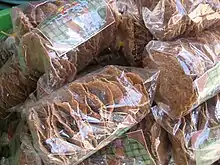Thua nao
Thua nao (Shan: ထူဝ်ႇၼဝ်ႈ; Thai: ถั่วเน่า; lit. 'rotten beans'), also known as pè bok (Burmese: ပဲပုပ်; lit. 'rotten beans'), is a fermented soybean product used in Burmese and Thai cuisine, particularly by the Shan, Tai Lue, and Northern Thai peoples as a cooking ingredient or condiment.[1] Thua nao is created by fermenting cooked soybeans with naturally occurring microbes.[1]
 Thua nao in the form of dried disks | |
| Alternative names | Pè bok |
|---|---|
| Place of origin | Myanmar |
| Region or state | Shan State |
| Associated cuisine | Burmese and Thai cuisine |
| Created by | Shan people |
| Main ingredients | Soybeans |
| Similar dishes | Other fermented soy products |
Fermentation
In the fermentation process, soybeans are cleaned, washed, and soaked overnight.[1] The soybeans are then boiled until they are soft, and then transferred to a bamboo basket and wrapped with banana leaves, enabling spontaneous fermentation to occur.[1] Thua nao is fermented using an alkaline fermentation process, using Bacillus microbes.[1]
Uses and forms

Thua nao is either cooked by steaming or roasting, or is further post-processed.[1] It is commonly used as a protein substitute.[1] Thua nao comes in two primary forms: fresh and dried.[1] The wet, fresh form, called pè ngapi (ပဲငါးပိ; lit. 'bean ngapi') in Burmese, has a short shelf life.[1]
The dried form is typically sold in the form of sun-dried flat disks, called thua nao khaep (ထူဝ်ႇၼဝ်ႈၶႅပ်, ถั่วเน่าแข็บ) or pè bok bya (ပဲပုပ်ပြား).[2][3] The dried disks are roasted and eaten on their own, or ground into a powder and mixed with salads.[3]
Thua nao is commonly used in Shan, Tai Lue, and Northern Thai cuisine, similar to how ngapi and shrimp paste are used in Burmese and central Thai cuisine.[4][3] Thua nao moe (ถั่วเน่าเมอะ) is a Northern Thai dish consisting of fermented beans that are wrapped in banana leaves and grilled or steamed, before being stir-fried or mixed with a chili dip.[5] In Burmese cuisine, dried thua nao is fried and eaten as a condiment, used as a dry relish that includes oil, fried onions, and garlic, or tossed into a salad with onions and chilies.[6][7]
In popular culture
- Sai Hsai Mao's "Me, the Little Shan Pè Bok" (ရှမ်းပဲပုပ်လေးကျွန်တော်) is a classic Burmese song.[8]
See also
- Fermented bean paste – Fermented foods made from ground soybeans
- List of fermented soy products
References
- Chukeatirote, Ekachai (2015-09-01). "Thua nao: Thai fermented soybean". Journal of Ethnic Foods. 2 (3): 115–118. doi:10.1016/j.jef.2015.08.004. ISSN 2352-6181.
- "Thua nao khaep". Lanna Food by Northern Thai Information Center (NTIC), Chiang Mai University Library, Chiang Mai University.
- Bush, Austin (2018-10-23). The Food of Northern Thailand: A Cookbook. Clarkson Potter/Ten Speed. pp. 224–227. ISBN 978-0-451-49749-9.
- "Tua Nao - Soybean Paste, Disks". Clove Garden. Retrieved 2023-05-14.
- "Thua nao moe". Lanna Food by Northern Thai Information Center (NTIC), Chiang Mai University Library, Chiang Mai University.
- "Eating paratha with chopsticks and such other Indian-ish stories in Burma". Harper Bazar. 2022-11-21. Retrieved 2023-05-14.
- Aye, MiMi (2019-06-13). Mandalay: Recipes and Tales from a Burmese Kitchen. Bloomsbury Publishing. pp. 314–315. ISBN 978-1-4729-5948-5.
- "တေးသံရှင် စိုင်းဆိုင်မောဝ် မန္တလေးမြို့ရှိ မန္တလာဆေးရုံ၌ ဆေးကုသမှု ခံယူနေရ". Eleven Media Group Co., Ltd (in Burmese). 2020-01-03. Retrieved 2023-05-14.